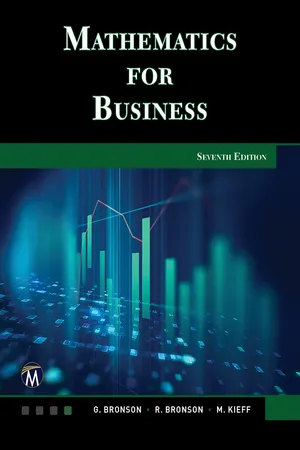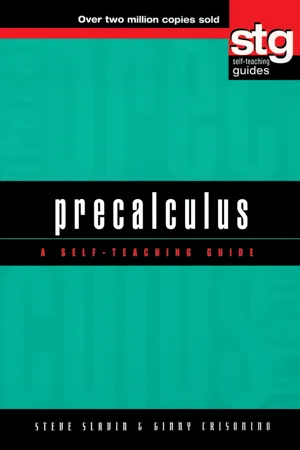Mathematics
Quadratic Function Graphs
Quadratic function graphs are parabolic curves that represent the relationship between a variable and its square. They are characterized by a U-shaped curve and can open upwards or downwards depending on the coefficient of the squared term. The vertex of the parabola represents the maximum or minimum point of the function, and the axis of symmetry divides the parabola into two symmetrical halves.
Written by Perlego with AI-assistance
Related key terms
Related key terms
1 of 4
Related key terms
1 of 3
6 Key excerpts on "Quadratic Function Graphs"
- eBook - ePub
- Gary Bronson, Richard Bronson, Maureen Kieff(Authors)
- 2021(Publication Date)
- Mercury Learning and Information(Publisher)
quadratic functions , and have the form:f (x ) = a 2 x 2 + a 1 x + a 0where a 2 ≠ 0. If we replace the constants a 2 , a 1 , and a 0 , by a , b , and c , respectively, this second-degree polynomial function is written in its more conventional form as:y = ax 2 bx + c (Eq. 3.8)In Equation 3.8, the variable that is squared is referred to as the quadratic variable , which in this case is x . Note that what determines if an equation is a function are not the symbols used in the equation, but whether the equation, domain, and range satisfy the definition of a function provided in Section 3.1 .Example 1 Determine which of the following functions are quadratic functions. For those that are, state their coefficients, a, b, and c.a. y = 2x 2 − ½b. y = 3x − x 2c. n 2 = 2p + 4Solutiona. This is a quadratic function in the variable x with a = 2, b = 0, and c = − 1/2.b. Rewriting this equation as y = − x 2 + 3x , we see that this is a quadratic function in the variable x with a = − 1, b = 3, and c = 0.c. Rewriting this equation as f (p ) = 1/2 n 2 − 2, we see that it is a quadratic function in the variable n , with a = ½, b = 0, and c = − 2.As in the case of linear equations and in part (c) of this example, the letters y and x - eBook - ePub
Differentiating Instruction in Algebra 1
Ready-to-Use Activities for All Students (Grades 7-10)
- Kelli Jurek(Author)
- 2021(Publication Date)
- Routledge(Publisher)
Unit Objectives As a result of this unit, students will know:- ➤ quadratic functions have an independent variable raised to a second power,
- ➤ when quadratic functions are graphed they are shaped like parabolas, and
- ➤ all quadratic functions have a vertex, a line or symmetry, and a minimum or maximum.
- ➤ quadratic functions can be written in three different forms, and each form provides key information about the quadratic;
- ➤ quadratic functions can have zero, one, or two solutions;
- ➤ quadratic functions can be solved using various methods; and
- ➤ quadratic functions model real-life situations.
- ➤ identify a quadratic relationship from a graph, table, or equation;
- ➤ find the vertex, axis of symmetry, and roots (zeros) from a graph, table, or equation;
- ➤ solve quadratic equations by graphing, factoring, completing the square, or using the quadratic formula; and
- ➤ interpret maximum and minimum points and intercepts in real-life applications.
Launch Scenarios
- ➤ After a soccer game, teammates shake hands to congratulate each other. How many handshakes are exchanged between a team with seven players? A team of nine players? A team of 11 players? (Lesson 2)
- ➤ You are putting a fence in your backyard to surround your garden, but you are limited to 24 meters of fencing. How should you arrange the fencing in order to maximize the amount of garden space? (Lesson 2)
- ➤ You want to put a decorative stone walking path along two adjacent sides of a water garden. The water garden measures 4 ft by 10 ft. How wide should the path be if there is enough decorative stone to cover 51 square feet? (Lesson 4)
- ➤ You are building a catapult to launch objects in your algebra class. How many feet away from the landing site do you have to place your catapult in order to hit the target? (Lesson 6)
- eBook - ePub
- Paul Turner, Justine Wood(Authors)
- 2023(Publication Date)
- Mercury Learning and Information(Publisher)
x -axis than the original curve.FIGURE 2.3 Parabolas with parameters 1 (solid line) and 2 (broken line).REVIEW EXERCISES – SECTION 2.11. Calculate the equations of the straight lines passing through the following pairs of coordinates.(a)(b)(c)2. Given the following equations for straight lines, calculate the values of x, which give(a)(b)(c)3. Variables x and y both vary with time according to the formulas and . This defines a curve in the Cartesian plane. Find the alternative representation in the form of an equation which links y and x .2.2 FUNCTIONSA function is a rule which takes an element from one set and maps it to the elements of another set. Although functions are often written in the form of equations, they are not the same thing.A function is a rule which associates objects in one set with objects in another set. For example, a function could be a rule which takes one number (the argument or input ) and uses it to assign another number (the output or result ). Equations are often used to define the rule, but simply writing down an equation relating two variables is not sufficient to define a function. To fully define a function, we must also specify the sets of numbers which are valid inputs and outputs of the relationship we define. A simple example is an equation of the form . For this to be a function, we must also specify the set of numbers from which x is drawn and the set of numbers that comprises the possible outcomes, y . These are referred to as the domain and the codomain of the function. For example, we can define a function using the relationships shown in (2.1):. (2.1)The first part of the definition consists of the equation . This defines the rule which takes x, the argument of the function, and maps it to y , the output . The second part of this function defines the domain and the codomain. In this example, we say that the function f “maps” the set of integers to the set of integers. The notation can be read as “f maps the set of integers to itself.” Note that the same equation could be used to map the set of real numbers to itself, that is, - eBook - ePub
- John Bird(Author)
- 2017(Publication Date)
- Routledge(Publisher)
When a mathematical equation is known, co-ordinates may be calculated for a limited range of values, and the equation may be represented pictorially as a graph, within this range of calculated values. Sometimes it is useful to show all the characteristic features of an equation, and in this case a sketch depicting the equation can be drawn, in which all the important features are shown, but the accurate plotting of points is less important. This technique is called ‘curve sketching’ and can involve the use of differential calculus, with, for example, calculations involving turning points.If, say, y depends on, say, x , then y is said to be a function of x and the relationship is expressed as y = f (x ); x is called the independent variable and y is the dependent variable.In engineering and science, corresponding values are obtained as a result of tests or experiments. Here is abrief resume of standard curves, some of which have been met earlier in this text. (i) Straight lineThe general equation of a straight line is y = mx + c , where m is the gradient(and c is the y -axis intercept.i .e .)d yd xTwo examples are shown in Fig. 20.1Figure 20.1(ii) Quadratic graphsThe general equation of a quadratic graph is y = ax 2 + bx + c , and its shape is that of a parabola. The simplest example of a quadratic graph, y = x 2 , is shown in Fig. 20.2 .Figure 20.2(iii) Cubic equationsThe general equation of a cubic graph is y = ax 3 + bx 2 + cx + d .The simplest example of a cubic graph, y = x 3 , is shown in Fig. 20.3 .Figure 20.3(iv) Trigonometric functions (see Chapter 15 , page 162)Graphs of y = sin θ , y = cos θ and y = tan θ are shown in Fig. 20.4 .Figure 20.4(v) Circle (see Chapter 14 , page 155)The simplest equation of a circle is x 2 + y 2 = r 2 , with centre at the origin and radius r , as shown in Fig. 20.5 .Figure 20.5More generally, the equation of a circle, centre (a, b ), radius r , is given by:+(2x − a)=(2y − b)r 2Figure 20.6 shows a circle+(2x − 2)= 4(2y − 3)Figure 20.6(vi) Ellipse The equation of an ellipse is+x 2a 2= 1y 2b 2and the general shape is as shown in Fig. 20.7 - eBook - ePub
Precalculus
A Self-Teaching Guide
- Steve Slavin, Ginny Crisonino(Authors)
- 2001(Publication Date)
- Trade Paper Press(Publisher)
a = −2, and −2 < 0. So as soon as we spot a minus sign in front of the first term of the quadratic, we know the parabola opens down. If there is no minus sign, then the parabola opens up.The Coordinates of the VertexThe vertex of a parabola is the highest point on a graph that opens down and the lowest point on a graph that opens up. One way to find the vertex of a parabola is to use the formula V: . The x coordinate of its vertex gives us its axis of symmetry. The axis of symmetry is the vertical line that passes through the x-coordinate of the vertex. Its equation is .Example 15:Find the vertex for the quadratic function f(x) = 2x2 + 8x + 7.Solution:The x-coordinate for the vertex of the function is .The y-coordinate for the vertex of the function is .The vertex is (−2,−1). Its axis of symmetry is x = −2.Example 16:Find the vertex and the intercepts for the quadratic function. Does it open up or down? Sketch the graph; f(x) = −x2 + 6x − 8.Solution:The x-coordinate of the vertex is .The y-coordinate of the vertex is y = f(3) = −(3)2 + 6(3) −8 = 1.Vertex: (3,1). Its axis of symmetry is x = 3.The intercepts are:We know this graph opens down because a is −1, which is less than 0.Find the vertex, intercepts, and sketch the graphs of the following functions:SELF-TEST 5:1.2.3.4.ANSWERS:1.2.3.4.The Shifting Technique for GraphingNow we’re going to show you a technique for graphing that applies to all of the basic types of graphs we’ll be working on in this book. On page 68 we showed the graph of the basic quadratic functions: y = x2 and y = −x2 . Both graphs have only one intercept, the origin, (0,0). Both graphs are shown below.Below are the graphs of four functions. Notice what effect adding or subtracting a constant to the basic quadratic functions y = x2 and y = −x2 - eBook - ePub
- Michael Harrison, Patrick Waldron(Authors)
- 2011(Publication Date)
- Routledge(Publisher)
Conic sections, quadratic forms and definite matrices
DOI: 10.4324/9780203829998-6 f4.1 Introduction
So far, we have concentrated on linear equations, which represent lines in the plane, planes in three-dimensional space or, as will be seen in Section 7.4.1 , hyperplanes in higher dimensions. In this chapter, we consider equations that also include second-order or squared terms, and that represent the simplest types of nonlinear curves and surfaces.The concepts of matrix quadratic form and definite matrix are of considerable importance in economics and finance, as will be seen in the detailed study of our several applied examples later. Quadratic forms relate importantly to the algebraic representation of conic sections. Also, in Theorem 10.2.5, it will be seen that the definiteness of a matrix is an essential idea in the theory of convex functions. This chapter gives definitions and simple illustrations of the concepts of quadratic form and definiteness before going on to establish a number of theorems relating to them. We will return to quadratic forms in Chapter 14 , where the important general problem of maximization or minimization of a quadratic form subject to linear inequality constraints is studied.4.2 Conic sections
In this section, we consider equations representing conic sections in two dimensions. There are a number of equivalent ways of describing and classifying conic sections. We begin with a geometric approach.1Consider the curve traced out in the coordinate plane ℝ2 by a point P = (x, y), which moves so that its distance from a fixed point (the focus S ) is always in a constant ratio (the eccentricity ϵ ≥ 0) to its perpendicular distance from a fixed straight line (the directrix L). This curve is called:- an ellipse when 0 < ϵ < 1;
- a parabola when ϵ = 1;
- a hyperbola when ϵ > 1; and
- a circle as ϵ → 0, as we shall see later.
4.2.1 Parabola
Consider first the case of ϵ = 1, i.e. the parabola. The equation of the parabola takes its simplest form when the focus S is a point on the positive x axis, say (a, 0), where a > 0, and the directrix is the vertical line with equation x = −a. An example of a parabola is shown in Figure 4.1
Index pages curate the most relevant extracts from our library of academic textbooks. They’ve been created using an in-house natural language model (NLM), each adding context and meaning to key research topics.
Explore more topic indexes
Explore more topic indexes
1 of 6
Explore more topic indexes
1 of 4





